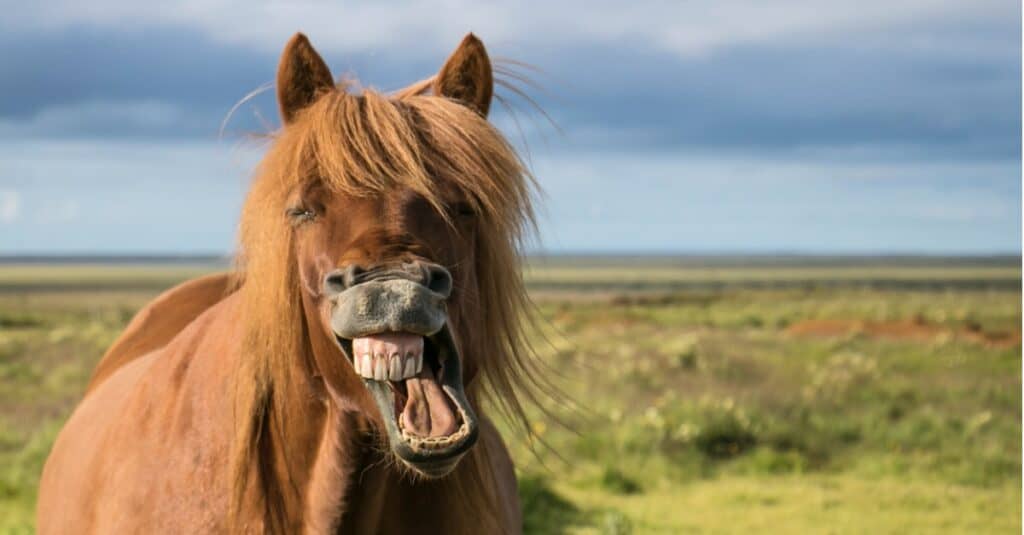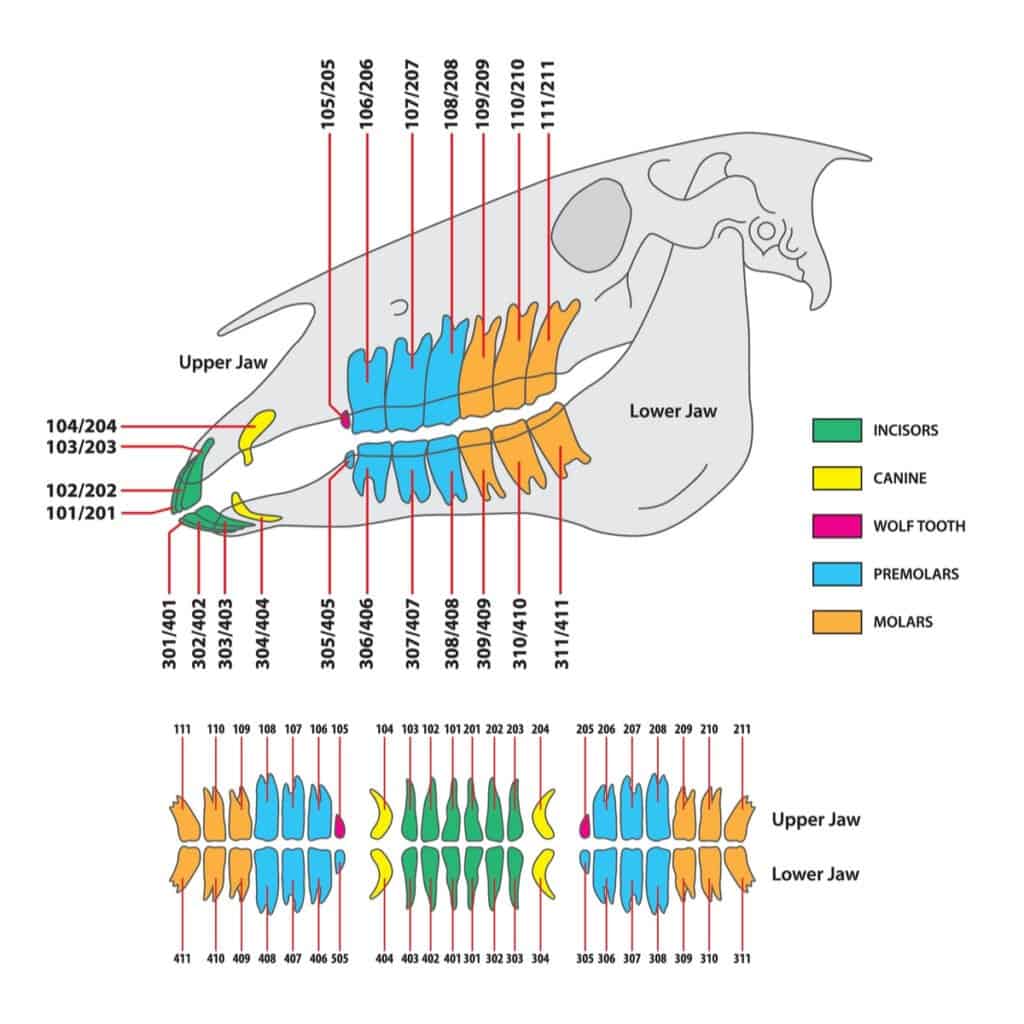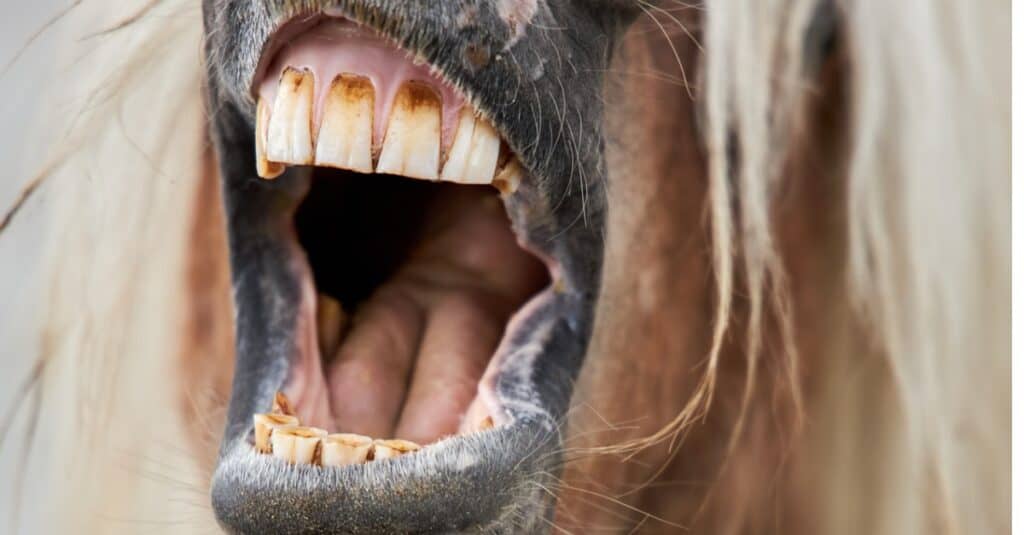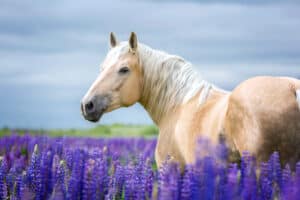Horses are majestic mammals that are well known for their flight response and ability to sleep standing up. They have been domesticated for centuries – doing everything from pulling carts, ploughing fields, racing, show jumping, pleasure riding, and much more. Horses are herbivores and originally grazed the plains in herds, and indeed some still do. Adults have between 36 and 40 teeth which are highly adapted for their forage diet. Also, did you know that you can tell the age of a horse by it’s teeth? Join us as we discover everything you need to know about horse teeth.
The Background on Horse Milk Teeth
In their lifetime horses have two sets of teeth. The first set is known as milk teeth or deciduous teeth, while the second set is their adult set. Horses have a unique tooth structure as they have six upper and six lower incisor teeth at the front of their mouths for pulling and tearing at grass and hay. They then have “cheek teeth” which are set right the way back into their mouths and are used for grinding and chewing their food.
Most horses have 24 milk teeth and the first tooth appears within one week of birth. The first two teeth to appear are their central incisors while their premolars (cheek teeth) appear by the time the foal is two weeks old. The rest of their incisors generally appear by the time they are nine months old.
When horses adult (permanent) teeth begin to appear they push the milk teeth up, which are then known as “caps”. This usually begins to happen when the horse is around two years old. Most caps are eventually shed on their own, but sometimes they need to be removed by an equine dentist to prevent discomfort. All of the milk teeth have usually been lost by the time horses are five years old. When this happens they are often said to have a “full mouth” as all of their adult teeth are present.

Horses have two sets of teeth in their life and they usually have all of their adult teeth by the age of 5
©iStock.com/chimpyk
The Dangers of Horse Wolf Teeth
Horses have five types of adult teeth and most begin to appear when the horse is two years old. However, wolf teeth usually erupt between the age of six to eighteen months. Wolf teeth are very small teeth that are found in front of the first upper premolar (cheek teeth). Not every horse has wolf teeth and even ones that do sometimes only have them on one side. Wolf teeth serve no purpose and often interfere with the bit when horses are in work. Therefore, they are often removed by equine dentists during routine checks.
Between the ages of 2 and 5 the adult incisor teeth and adult premolars and molars appear. Again, horses have six upper and six lower incisors and twelve upper and twelve lower cheek teeth. Although adult horses do have molars and premolars they essentially have the same appearance and function. Cheek teeth continue to erupt throughout most of a horses lifetime as they gradually wear them down. Therefore, in young adult horses, most of their cheek teeth are actually below the gum line as they are 4.5 to 5 inches long. However, by the time horses reach old age their is often very little crown left on the tooth as most of it has been worn away over the years. This means that older horses with very worn teeth often need a specialized diet which is soft and palatable.
The final type of adult teeth are canine teeth. These are short, sharp teeth that appear in the gap between the incisor and cheek teeth at around 4 to 5 years. However, not every horse has them and they are found on males more often than females. Like wolf teeth they actually serve no purpose.

Wolf teeth serve no functional purpose and are often removed.
©Rainer Lesniewski/Shutterstock.com
Telling a Horse’s Age
The most reliable way to tell a horses age is to look at it’s teeth, and this method is frequently used around the world. In younger horses that still have their milk teeth (under 5 years old) the best way is to look at which teeth are present However, in some breeds – such as Shetland ponies – the middle and corner incisors appear later than in usual which can sometimes make ageing younger horses more difficult.
However, horses over five years old can be accurately aged by looking at the appearance of their incisor teeth. The first thing to look at is the angle of the incisors as the slope becomes more apparent the older the horse is. Also, the shape of the teeth is important. The younger the horse is, the more oval shaped the flat surface of their teeth is. As they age the teeth become triangular shaped and then eventually rectangular.
Another key identifier in their teeth is the “seven-year hook”. This is when the upper corner incisor begins to show some wear and develops a noticeable “hook” on it around the age of seven. It disappears a year later, but sometimes reappears when the horse is thirteen and again disappears a year later.
Additionally, Galvayne’s groove is a vertical line that appears in the front of the upper third incisor at 10, is halfway down at 15, and fully down by 20 years of age. After the age of 20 it begins to recede again and is halfway gone by 25 and disappears at 30 years old.

A horses age can be determined by the wear and markings on its teeth.
©iStock.com/ovbelov
Cups and Stars
Horses incisor teeth also have distinctive markings on the flat “table” part of them that are called cups and dental stars. Cups are dark brown, hollow indentations in the enamel and are worn away as the horse ages. Cups are generally gone by the time the horse is eight years old and the table of the teeth are smooth. In their place are dental stars which only appear around at around eight years of age. Dental stars begin as a line on the flat surface of the tooth, but then become a large, round spot as the teeth are worn down further. The dental star begins in the first incisor before appearing in the second and third incisors.
Check out the table below to see how the cups and stars appear and change in horses teeth.
| 1st incisor | 2nd incisor | 3rd incisor | |
| Cups gone | 6 years | 7 years | 8 years |
| Dental star (line) | 8 years | 9 years | 10 years |
| Dental star (round) | 9 years | 10 years | 11 years |
Dental Problems

Horses need routine dental care for their teeth as they wear down unvenly.
©Jaromir Chalabala/Shutterstock.com
In the wild, horses teeth wear down more than those of domesticated horses due to their constant grazing and foraging. However, many horses teeth wear down unevenly. This causes sharp edges which can be uncomfortable. Therefore, most domestic horses require routine teeth checks by a vet or a specialist equine dental technician (equine dentist) or they can begin to have problems eating, or issues when wearing a bit in their mouth. Equine dentists are able to use special tools to file away these sharp edges so that the horses teeth are even again. They also often remove loose caps or troublesome wolf teeth.
The photo featured at the top of this post is © iStock.com/chimpyk
Thank you for reading! Have some feedback for us? Contact the AZ Animals editorial team.






